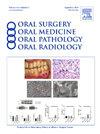Benign fibro-osseous lesions of the jaws (BFOLJ): a pilot study of 88 cases
IF 1.9
3区 医学
Q2 DENTISTRY, ORAL SURGERY & MEDICINE
Oral Surgery Oral Medicine Oral Pathology Oral Radiology
Pub Date : 2025-07-21
DOI:10.1016/j.oooo.2025.04.052
引用次数: 0
Abstract
Introduction
BFOLJ comprise a heterogeneous group of conditions with variable biologic behavior and overlapping radiographic and histopathologic features. Their diagnosis relies heavily on clinicopathologic correlation. Generally, BFOLJ is sub-categorized into cemento-osseous dysplasia (COD), ossifying fibroma (OF), and fibrous dysplasia (FD). Herein, we present our institutional experience regarding the epidemiologic and clinicopathologic characteristics of BFOLJ.
Material and Methods
Archived BFOLJ cases over a 4-year period (2018-2022) were retrieved from the electronic laboratory databases of the OSU oral pathology service. Available information regarding patient age and gender, anatomic location, lesion focality, i.e., solitary or multifocal, radiographic appearance and size, clinical impression, and subtype was recorded.
Results
Among 21,462 biopsies, 88 (0.41%) cases of BFOLJ were identified; 68 (77.3%) affected women and 20 (22.7%) men (F:M = 3.4:1; age range = 7-90 years, mean = 38.8 years). The posterior mandible was the most common location (62, 70%). Seventy-seven (87.5%) BFOLJ were unifocal and 11 (12.5%) showed a multifocal pattern. Radiographically, 42 (48%) cases presented as well-defined, mixed radiopacity/radiolucency, 15 (17%) as unilocular radiolucency, and 9 (10%) as radiopacity (mean size = 1.9 cm, range = 0.4-10 cm). BFOLJ was a clinical consideration in 49 (56%) cases. Seventy-one (81%) BFOLJ were diagnosed as COD (F:M = 6.1:1; age range = 7-90 years, mean = 39 years). Other BFOLJ included OF (9, 10%; F:M = 4:5; age range = 12-47 years, mean = 28 years), juvenile OF (3, 3.5%), FD (3, 3.5%), osteoblastoma (1, 1%) and renal osteodystrophy (1, 1%). Twelve (13.6%) BFOLJ were associated with other lesions including traumatic bone cyst (4, 33.3%), as well as 2 (16.7%) each of periapical cyst, xanthoma of bone, odontoma, and central giant cell lesion.
Conclusions
BFOLJ are relatively uncommon, largely representing forms of COD with a strong predilection for the posterior mandible of women in their 4th decade. Overall, BFOLJ displays nonpathognomonic radiographic features. Histopathologic examination and clinical-radiographic correlation are required for definitive diagnosis and proper management.
颌骨良性纤维骨性病变(BFOLJ): 88例的初步研究
bfolj包括具有可变生物学行为和重叠的放射学和组织病理学特征的异质组。他们的诊断很大程度上依赖于临床病理相关性。BFOLJ一般分为骨质发育不良(COD)、骨化纤维瘤(OF)和纤维性发育不良(FD)。在此,我们介绍了我们在BFOLJ的流行病学和临床病理特征方面的机构经验。材料与方法从俄勒冈州立大学口腔病理服务电子实验室数据库中检索4年(2018-2022年)的BFOLJ病例。记录患者的年龄和性别、解剖位置、病灶病灶(即单发或多灶)、影像学表现和大小、临床印象和亚型等信息。结果21462例活检中,发现88例(0.41%)BFOLJ;女性68例(77.3%),男性20例(22.7%)(F:M = 3.4:1;年龄范围 = 7 ~ 90岁,平均 = 38.8岁)。后下颌骨是最常见的位置(62,70%)。77例(87.5%)为单焦型,11例(12.5%)为多焦型。放射学上,42例(48%)表现为界限分明、混和的放射不透/透光,15例(17%)表现为单眼放射不透,9例(10%)表现为放射不透(平均尺寸 = 1.9 cm,范围 = 0.4-10 cm)。49例(56%)患者临床考虑BFOLJ。71例(81%)BFOLJ诊断为COD (F:M = 6.1:1;年龄范围 = 7 ~ 90岁,平均 = 39岁)。其他BFOLJ包括OF (9.10%;F: M = 4:5;年龄范围 = 12-47岁,平均 = 28岁),青少年OF (3.3.5%), FD(3.3.5%),成骨细胞瘤(1.1%)和肾性骨营养不良(1.1%)。BFOLJ合并其他病变12例(13.6%),包括外伤性骨囊肿4例(33.3%),根尖周囊肿、骨黄色瘤、牙髓瘤、中央巨细胞病变各2例(16.7%)。结论sbfolj相对少见,主要代表了COD的形式,并强烈倾向于40岁左右的女性后下颌骨。总体而言,BFOLJ表现出非病理性的影像学特征。组织病理学检查和临床放射学相关性是明确诊断和适当处理的必要条件。
本文章由计算机程序翻译,如有差异,请以英文原文为准。
求助全文
约1分钟内获得全文
求助全文
来源期刊

Oral Surgery Oral Medicine Oral Pathology Oral Radiology
DENTISTRY, ORAL SURGERY & MEDICINE-
CiteScore
3.80
自引率
6.90%
发文量
1217
审稿时长
2-4 weeks
期刊介绍:
Oral Surgery, Oral Medicine, Oral Pathology and Oral Radiology is required reading for anyone in the fields of oral surgery, oral medicine, oral pathology, oral radiology or advanced general practice dentistry. It is the only major dental journal that provides a practical and complete overview of the medical and surgical techniques of dental practice in four areas. Topics covered include such current issues as dental implants, treatment of HIV-infected patients, and evaluation and treatment of TMJ disorders. The official publication for nine societies, the Journal is recommended for initial purchase in the Brandon Hill study, Selected List of Books and Journals for the Small Medical Library.
 求助内容:
求助内容: 应助结果提醒方式:
应助结果提醒方式:


